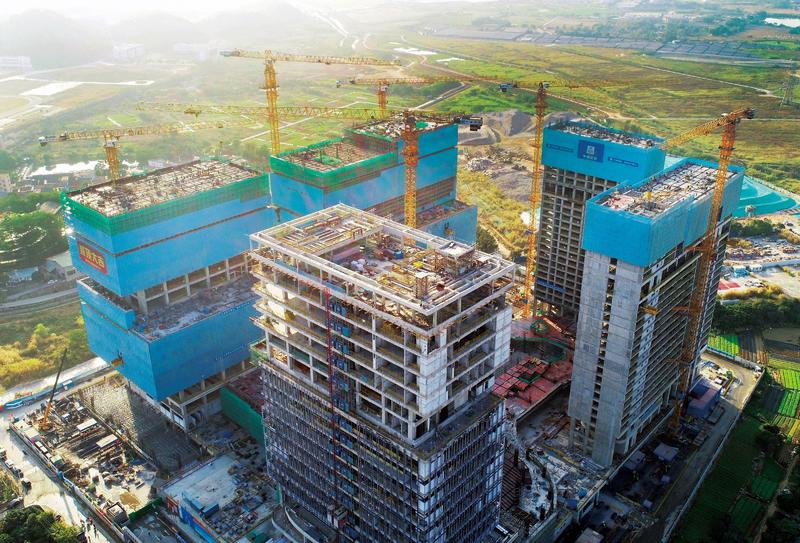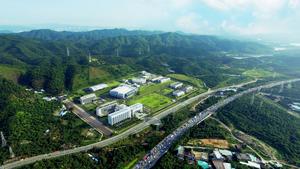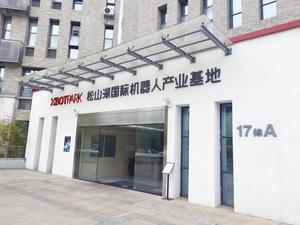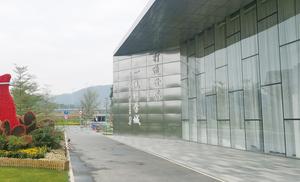A comprehensive national science center in the Bay Area, with science towns, is spearheading a major push to stimulate original innovation, incubate new industries and provide platforms for the country to participate in global technology competition. Chai Hua reports from Shenzhen.
 The main buildings take shape at Guangming district science town in Shenzhen. (PHOTO PROVIDED TO CHINA DAILY)
The main buildings take shape at Guangming district science town in Shenzhen. (PHOTO PROVIDED TO CHINA DAILY)
Professors from the University of Hong Kong have achieved a remarkable scientific feat — developing a creative method to make ultra-strong steel that can even outperform aerospace steel.
The accomplishment was notable enough to make its way to Science Magazine of the American Association for the Advancement of Science, one of the world’s top academic journals that recently published the discovery.
However, an essential contributor to the academics’ research data is less known outside the science field — the China Spallation Neutron Source — the only one of its kind in China and one of the world’s four spallation neutron sources, besides those in the United States, the United Kingdom and Japan.
Located in the budding comprehensive national science center in the Guangdong-Hong Kong-Macao Greater Bay Area, CSNS is among an array of top-end, large-scale science research facilities built or being built at the center.
Making fair use of these facilities, the area is gearing up to strengthen original innovation and incubate new industries. More importantly, the Hong Kong professors’ success signaled that the center is no longer merely a plan promised in policy documents. Many of its facilities and buildings are already in place and have attracted researchers and technology firms.
 Dongguan’s Songshan Lake science town houses the China Spallation Neutron Source. (PHOTO PROVIDED TO CHINA DAILY)
Dongguan’s Songshan Lake science town houses the China Spallation Neutron Source. (PHOTO PROVIDED TO CHINA DAILY)
Guangdong province’s robust production ability is quickly translating innovations into products, while Hong Kong universities and startups have weaved themselves into the science center’s innovation network.
Unlike regular high-tech zones or technology incubators on the Chinese mainland, which usually depend on importing top technology firms, a comprehensive national science center focuses on building large-scale scientific research facilities and institutions to stimulate original innovation and incubate its own stars.
According to the official description, it aims to become a foundation of the national innovation ecosystem and a crucial platform for the nation to participate in the global technology competition.
Besides the center in the Bay area, there’re only three hubs with such title in the country — in Beijing, Shanghai and Hefei, Anhui province. Many other cities, including Chengdu in Sichuan province and Wuhan in Hubei province, are also on the same trail.
In 2019, the central government explicitly pinned Shenzhen as the principal city of a new comprehensive national science center in the guideline on supporting the city in building a pilot demonstration area of socialism with Chinese characteristics.
 Xbot Part at Songshan Lake science town in Dongguan. (CHAI HUA / CHINA DAILY)
Xbot Part at Songshan Lake science town in Dongguan. (CHAI HUA / CHINA DAILY)
Science towns
The National Development and Reform Commission and Ministry of Science and Technology agreed last year to promote two science towns in Shenzhen’s Guangming district and Songshan Lake Hi-Tech Industrial Development Zone in Dongguan as key drivers of the Bay Area’s national science center.
The Chinese Academy of Sciences — one of the nation’s highest scientific and technology research institutions — signed cooperation agreements with the Shenzhen and Dongguan governments in November to jointly build the center.
The two science towns have already built many office buildings, factories and living facilities there, such as schools, residential homes and hospitals. These facilities and industry chain firms have laid a solid foundation to woo new high-end talent, startups, research institutions and firms in order to form the science center as soon as possible.
Their main task now is to build a new batch of large-scale scientific study facilities, universities and research institutions, many of which are nearing completion. Construction of the main structure housing large-scale scientific study facilities for brain analysis, brain simulation and synthetic biology was completed this month in Guangming science town. The five-building complex, covering an area of about 230,000 square meters, is expected to go into operation next year.
Another large-scale scientific facility for the study of integrated particles began construction in August last year. The second phase of the national supercomputing center, a precision medical imaging device and a set of special environmental science equipment are in the pipeline.
Meanwhile, Sun Yat-sen University has launched its Shenzhen campus and started accepting students last year, while CAS initiated its fourth university nationwide in the district late last year.
Since the establishment of the Shenzhen special economic zone in 1980, the Guangming area has remained dotted with animal rearing farms. In 2018, the new Guangming District was founded, tasked with building a top-end scientific town. The local government has so far invested about 11 billion yuan (US$1.7 billion) in the project that covers an area of 99 square kilometers, about two-thirds of the entire district.
Guangming District Governor Liu Sheng said the science town will be merged with the Bay Area’s basic research and applied basic research facilities. “Based on basic research, we’ll establish a step-by-step cultivation system of technology firms — from budding startups and graduated projects and from incubators to national high-tech firms, high-growth enterprises and industry champions.”
Dongguan’s Songshan Lake science town, a 30-minute drive from Guangming, houses the CSNS. Jointly built by Guangdong and the CAS in 2011, the CSNS began operations in 2018, serving more than 1,500 users from around the globe. The local authorities aim to start building CSNS’s second phase once approval is obtained and open eight new spectrometers.
The CSNS is like a super microscope, with each spectrometer to be used in each scientific research sector. Next to the CSNS, a new building complex is emerging. It’s the new Songshan Lake Materials Laboratory, which completed registration in 2018 and has been working in a temporary office nearby.
Wang Enge, vice-president of the CAS and chairman of SLAB, told a forum last year the lab has incubated a few startups based on their scientific research achievements.
Some products have been widely used in the manufacturing sector, such as new combustion materials for pollution reduction and scarce parts to make N95 masks. “We’re pushing for an innovative model factory to facilitate industrialization and export transformation,” said Wang.
Other companies could also apply for the usage of various test and measurement equipment at the lab or send their samples to the lab for tests.
 The slogan “Building a world-class science city“ is clear on an exterior wall of the exhibition hall at Guangming district science town. (CHAI HUA / CHINA DAILY)
The slogan “Building a world-class science city“ is clear on an exterior wall of the exhibition hall at Guangming district science town. (CHAI HUA / CHINA DAILY)
Hong Kong’s part
Hong Kong is also an active participant at the comprehensive national science center. The Chinese University of Hong Kong is building its second Shenzhen campus at Guangming science town, while the City University of Hong Kong aims to open a new mainland branch near Songshan Lake.
CUHK has teamed up with CSNS to set up a multi-physics spectrometer, which is due to begin operations in the second half of this year.
What’s more, both science towns have incubators for Hong Kong and Macao startups with rental-free offices and capital support. Song Hongping, general manager of SmartMind Technology, said they’re working with a dozen budding startups at a Guangming incubator that opened last year.
Song founded the startup engaged in artificial intelligence-based 5G filter testing technology with a doctor who graduated from CUHK. He said his business partner had tried to set up his own firm, but found his research results often failed to keep up with market demand.
He then invited Song, who’s more experienced with the local 5G industry supply chain.
At Songshan Lake science town, Xbot Park has become a base for many professionals from Hong Kong. It was jointly set up in 2014 by Li Zexiang, a professor of the Hong Kong University of Science and Technology, who is also known as the “godfather of drones” after having incubated drone-maker DJI.
The park has taken in many Hong Kong students and incubated more than 80 firms, some of which have climbed to the top of the industry.
Shi Jinbo followed Li to Dongguan and co-founded Quotient Kinematics Machine, an industrial robot producer.
Shi said the rich resources of manufacturing suppliers are among the area’s major advantages. “For instance, one of our industrial robots needs about 800 components and all could be found in factories within a one-hour drive from the area.”
But the difficulty lies in recruiting high-end technology professionals and retaining them, compared with companies in first-tier cities. “There’s an aura of scientific and technological research forming around Songshan Lake,” she said. “This will attract more talents who’re willing to get involved in frontier technologies.”
In addition, the Hong Kong-Shenzhen Innovation and Technology Cooperation Zone, wedged between the two cities and operated jointly by the two cities, is positioned to be a pilot zone for innovation and open for the Bay Area’s comprehensive national science center.
Although the Hong Kong section is still under land rehabilitation, the Shenzhen part, a bonded zone in Futian district, has transformed its existing factories and warehouses into new-technology research spaces, incubating more than 130 projects from both sides.


